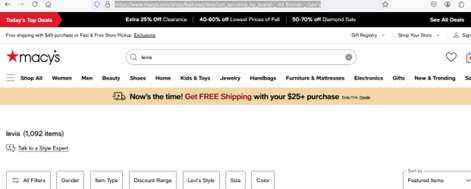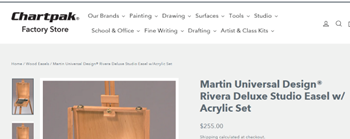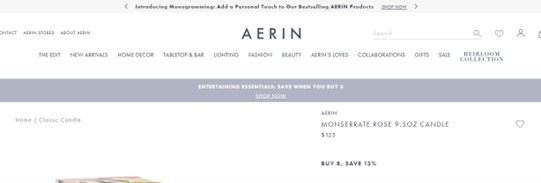As online sales take over the retail market, it is essential to show strong trademark use of the marks on retail websites to maintain brand identity and support the trademark filings. There are specific requirements in the way one uses the mark on a website so that the USPTO will accept it as trademark use. For trademark owners that sell products as well as run a retail store, there can be applications for the online retail store services and also for the goods sold, assuming those goods are branded with the trademark owner’s trademark. An online retail store that sells the brands of others and not its own brand would not be able to use the website in support of an application for goods.
To show use of the mark in connection with online retail store services, the mark must appear prominently on the site, separate and apart from other terms, in such a way that conveys it is the overall brand of the online store. Think of it as the store “signage.” Prominent placement in the upper left corner or centered at the top are common and successful means of doing this, preferably carrying this over to each webpage on the site. See for example www.gap.com, which would likely support a trademark application for Gap for online retail store services (see also below):

On the other hand, this example below is unlikely to support an application for Levi’s for online retail stores.

The use of the mark Macy’s at the top clearly indicates that Macy’s is the brand of the online store, which is selling goods of a third party. We do not believe this would be an acceptable specimen of use for Levi’s for an online retail store. The use on the Levi's website would likely work, however. Other well-known examples of online retail stores selling third party goods are Amazon, Walmart, Bloomingdales and Kohl’s.
Websites such as Amazon, Macy’s and Walmart can be used to show use of the mark on goods, but the mark must appear in direct connection with the item itself, appearing prominently separate and apart from other terms. Think of this as a “point of sale” use as if in a store where the item is sold with a sign on the shelf. This can seem a bit more complicated, but there are easy ways to accomplish this.
1. Placing the mark on a separate line in the description of the product is an effective way to do this as with the following easel example where the mark Martin Universal Design for art easels appears in a separate line from the rest of the description. The mark is also shown on the ecommerce site near an “add to cart” button, and the item is listed as in stock and ready to ship (see below).

2. Another option is to show a close-up of the label appearing on the actual item in a photo, clearly showing the mark, or placing it somewhere in close proximity to same such that it is clear that is the brand of the item. For example, this use on Amazon would likely be an acceptable specimen of use for the mark Spectra AD for markers.
Confusion with acceptable goods specimens can arise when the brand of the website is also the brand of all the items sold therein. Even though the owner only sells its brand of goods, to use an ecommerce website as a specimen of use for the goods, the mark must still appear in the description of the goods (separate and apart from other terms) or in close proximity therewith. An example that shows use of the mark both as the online store and as the brand of the item may be found at AERIN candle, which shows the use of AERIN as both an online store name and as a brand of the product. (see below)

TAKEAWAY: Placement of a mark to protect the online store service is different than that needed to protect a mark covering the goods themselves. It is therefore important to appropriately place the mark to ensure you are obtaining the protection desired.




